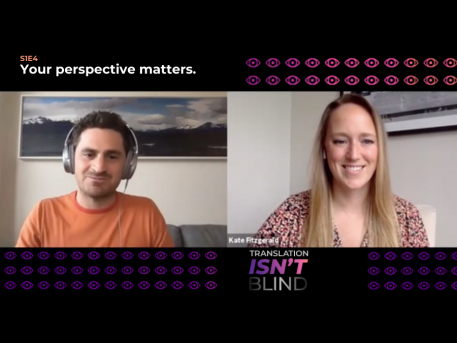Translation Isn't Blind: Your perspective matters. from Smartling on Vimeo.
If you can’t buckle in for our webinar, jump right in!
- 5:38 - Smartling’s official statement on injustice.
- 7:50 - Learning about machine translation (MT) engines available outside of Smartling.
- 11:10 - Accuracy of MT from the recent past/referenced-based MT.
- 16:08 - How Smartling approached comparing translation quality of human translation (HT) and MT.
- 23:30 - Justifying the subjective nature of the quality in terms of translation.
- 25:39 - Managing internal stakeholders.
- 28:44 - Managing external stakeholders.
- 31:16 - Remembering that quality concerns are sometimes confused with language choice preferences of internal reviewers or external stakeholders.
- 40:07 - Asking the right questions before targeting different locales.
- 41:32 - Recommendations for clean up and consolidation of translation memories (TM)
- 43:21 - Fitz says hello!
- 48:45 - Tips for working with folks who aren’t professional linguists.
- 49:18 - Difference between transcreation and creative translation.
Every person brings a unique history and churning brain to the table and collectively we see the world through our own eyes.
In the translation world, we are always trying to get on the same page. This week Adrian and Kate have shared their thoughts on some of the more common questions we see in translation during this episode and the main takeaway is: your perspective matters. Yes, yours!
“Everyone has a unique voice and everyone is trying to preserve it”
My budget has been cut. How can I keep projects going and needs met?
Since the COVID pandemic first made its debut businesses, in addition to people, have been feeling the effects. Budgets have been slashed and teams have been thinned out.
If you’re dealing with a tighter budget to work with through Q4, there are ways Smarling can help.
Quick tips:
- Select content that immediately needs translations and put a dollar amount against it (we help you understand the value of your content in this article).
- Determine translation resources - do you need an extra step to ensure one round of edits? Are you looking for translation only?
- Suss out and prioritize content (see internal reviews) if it has the potential to cause harm.
How can I manage internal stakeholders who push back on quality?
Just as we each see the world in our own way, internal stakeholders will likely have questions about the quality of some translations. These questions can help you to field whether or not this is merely (often meritless) opinion or if it is vital pushback that can help you further improve your project and content:
Understand
Ask them to elaborate. Seek to understand before pushing to be understood. “Tell me more. What do you think could be different? If you were doing the translation, what would you have done?”
Educate
Explain your process and the steps that have been put into place to curb challenges regarding quality and substantiate with statistics (Smartling can help you pull critical data). “Let me show you the steps we take to ensure quality. This has proven to provide ___% improvement and lower ___% margin of error.”
Loop them in
Get them involved. Invite them to share the bulkload of the responsibilities of managing a project so they can see the process, speak up if they have suggestions and ultimately they may have a more profound understanding of the steps.
“Would you be open to leading/shadowing me on the next batch of translations for our upcoming campaign?”
How can I tighten up my quality assurance?
If you’re looking to bolster your quality assurance, first analyze where you’re starting from.
Reprioritizing quality, retranslating, and resetting quality standards for your brand should be prefaced with a few important questions:
What is the quality issue: bad translators, typos, outdated content? Is it a matter of preference? Are there duplicate or multiple entries for the same string?
Possible solves include:
- Penalize content (pay more per word)
- Update style guide and glossary
- Communicate to translators what to do (passive vs active changes)
- Look out for style, modernizing content, etc.
- Remove duplicates
Has your product shifted? Producing a new brand? Changing the conversation with the audience? Opting for a fresh start? These all point to revamping!
Once you have answered those questions, Smartling can help you get where you want to go.
What is the difference between transcreation and creative translation?
Ah, the age-old question. This one comes up frequently for us, so we will make our answers as simple as possible.
Transcreation is an in-depth process in which the translator reworks the words of slogans and other types of smaller content in order to be hyper-relevant. Translators are able to use their individual creativity and cultural knowledge to reach and resonate with a new audience.
Transcreation specialists are career writers who begin each project with a creative brief and produce text that aims to trigger an action from the reader. Transcreation is about creating new content that captures the brand voice and message in an entirely new language.
Think about brand logos or taglines. They're meant to evoke emotion, sometimes to inspire, sometimes to motivate, and that sometimes makes them really hard to translate! Instead, transcreators are tasked with developing that content that retains the essence of the message but resonates with a different culture.
On the other hand creative translation focuses more-so on replacing the actual words in one language with corresponding words in a new language, but with a bit extra flare.
As opposed to basic and bog-standard translation, creagive translation is about keeping the original wording and sentiment of the text, but creatively translating it to ensure that the initial mesesage remains more or less the samee.
That’s a wrap!
Well, that was a lot of info. We hope we answered some of your burning questions in this week’s episode of Translation Isn’t Blind.
An evergreen reminder: every customer and every project will be different. Smartling is here to help and guide you through every aspect of your translation process. You can book a demo right here!
Translation Isn't Blind
We're bringing translation into focus during our new mini webinar series, Translation Isn't Blind. There’s an ongoing appetite to debate the value of internally reviewing translation. Do you kill it, or optimize it? During this episode, we dive into how you can optimize your process so that you can do a little bit of both.
Translation Isn't Blind has more in store! Check out our previous and upcoming episodes below. 👇
S1 E1: Navigating Global Crises
During the season premiere episode, Kate Fitzgerald and Adrian Cohn covered the tools and resources you need to respond to crises and evolving situations as the world responds to COVID-19. View the recording here.
S1 E2: Internal Review: Kill it or optimize?
We covered the in's and out's of internally reviewing translation: an “insurance policy” that is designed to minimize a company’s exposure to publishing low quality - or unacceptable - translations. So, what should you do: kill it, or optimize internal review? Yes, you can - you can do one, or the other, or a little bit of both. View the recording here.
S1 E3: Does quality even matter anymore?
It’s the provocative question we’ve been waiting to discuss in the translation space. Some say translation quality is paramount, while others may say speed is more important. Learn how you can do both during this episode of Translation Isn't Blind. View the recording here.
S1 E5: We translate because...
Conventional wisdom tells us that translation expands reach; and reach drives revenue. But what about unconventional wisdom - the out-of-the-box reasons for translating? As Dr. Stephen Covey says, “Seek first to understand, then to be understood.” Reframe how you talk about translation internally through untold stories about why other businesses translate. Register here.
S1 E6: Help me convince my manager
“Translation” lives in different places from one company to the next. Sometimes it’s managed by localization teams, and other times it’s managed by the product team. No matter how your organization decides who owns translation, it’s important that you reveal to your manager how and why translation adds value to the business - how translation isn’t blind. Register here.
About Laura
Laura Wyant is a freelance digital strategist and writer/editor. She is currently working with start-ups, tech companies, and health and healing spaces. Laura has been contributing to the Smartling blog on topics around cloud translation, digital strategy, and overall creative translation process. When she isn’t working in media, she is working to educate herself on matters such as intersectional women’s health and advancements in technology.









